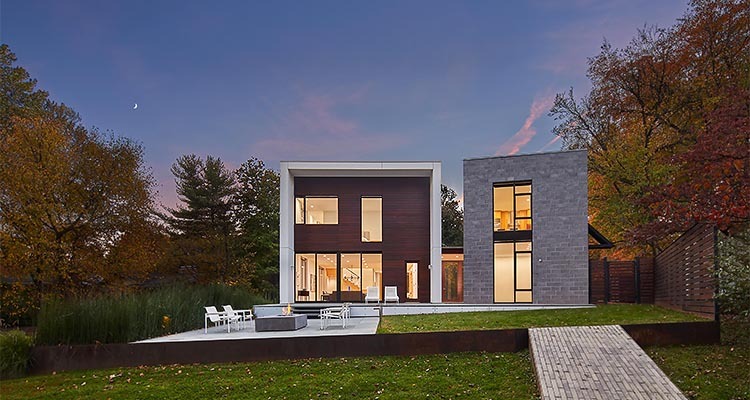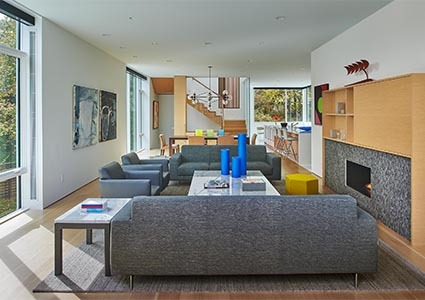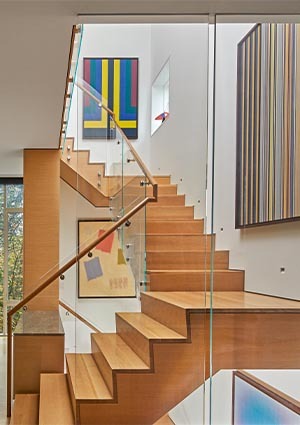
How Peterson and Collins Builders constructed a unique home for one of its owners, Ted Peterson
Peterson and Collins is an award-winning custom homebuilder specializing in high-end residential construction. The firm’s core philosophy is executing flawless superior craftsmanship. With 47 years in business, the company has created an enduring legacy of unique homes that demonstrate the principle that it is possible to achieve excellence without sacrificing efficiency. Its clients enjoy the process of receiving a top-quality home, constructed to the highest standards on time and within budget.
 The business was founded in 1977 by George Collins and Ted Peterson, who met while teammates on the Bucknell University soccer team. Upon graduation, the pair decided to combine their entrepreneurial outlook and building skills to embark on a business that has since brought them an abundance of success. They have since tackled new construction, renovation, and historic restoration across Washington DC, Maryland, and Virginia.
The business was founded in 1977 by George Collins and Ted Peterson, who met while teammates on the Bucknell University soccer team. Upon graduation, the pair decided to combine their entrepreneurial outlook and building skills to embark on a business that has since brought them an abundance of success. They have since tackled new construction, renovation, and historic restoration across Washington DC, Maryland, and Virginia.
One of the company’s latest projects, the Levelle Drive residence, is a house with a twist, as it was constructed for its very own Ted Peterson. The property was designed to stand out as an example of architecture as art. Ted joins us from Levelle Drive to share more details on the construction process and how he’s made this house, his home.
“If you can live in one custom designed modern home at this artistic level, you’re very fortunate, but I’ve been privileged to live in not one, but two stunning homes,” Ted opens. “I previously lived in our Quincy Street residence, which was my first collaboration with architect, Robert Gurney. From this project grew a strong 25-year relationship during which we have constructed many of his signature designs.
“When it came to my new house on Levelle Drive, I knew I wanted something modern, and I wanted Robert Gurney to design my home. Having collaborated with him for quite some time, I have the highest regard for his talent, and I trusted his vision. My only request was that the project be designed and constructed in two phases, where an accessory apartment, located above the garage building, would be completed in phase one which would allow me to move in quickly. Phase two, the main house, would be executed over an extended period. The accessory apartment could ultimately be used as a separate living space for family, guests, or staff.
An architectural twist
“The site had an existing rambler, which we took down to the first floor, and the design came from there. It was amazing to watch Robert quickly produce a preliminary schematic design that ultimately ended up being remarkably close to the final design. When it came to construction, Robert’s designs are built under what we call a Zero Tolerance Policy, which means that each component must be within one eight of an inch because modern design does not involve trim that conceals variances. In other words, it’s either perfect, or it must be redone.
“Although we constructed the house like any other, everyone who worked on the project was, of course, conscious that they were working on ‘Ted’s home’,” he laughs. “Suddenly, I was no longer just the builder, but instead the client and the builder, so now I have a greater appreciation of the process and relationship between the architect, the builder, and the owner. We spared no expense in the execution and quality of the materials, as I knew from experience that the better the materials, along with superior building science, we could produce a home that would last for fifty or even one hundred years. The result is an amazing home that I feel blessed to live in and gives me joy every single day.”
A collection for the ages
Ted’s passion for architectural art also extends to his interior design preferences, and he embarked on an art acquisition spree once his home was completed, with the goal of designing a museum style space. “I have gained a greater appreciation for art throughout my career,” he reflects. “I have a particular love for a movement called the Washington Color School, a group of local Washington DC abstract expressionist artists whose pieces reflected the abstract art changes that occurred during the 1960s and 1970s. I’ve focused my personal collection on the movement, and I’ve been truly fortunate to acquire artwork of the seven major artists that define the Washington Color School. 
“When it comes to my home, the collection completely transforms the interior space while being complementary to the architecture. With white walls, no trim, and reconstituted white oak millwork, the architecture is stark, almost museum-like, and the interior comes alive with different forms of art, from prints and photographs, mixed media collage, and textile art to original paintings and sculptures.
“However, I realized early on that due to the amount of glass floor to ceiling windows and limited walls, and the house doesn’t have many open spaces to display art,” he explains. “To add to that complexity, I acquired many of the pieces via an online auction, meaning the art purchasing process involved a combination of the size and colors of the art, the location where the art would be installed, as well as the all-in acquisition costs. I have been truly fortunate to have established a relationship with Douglas Gold of the Lincoln Glenn Gallery in NYC. Douglas has functioned as my art representative and has given me critical advice to inform good buying decisions. He, along with Robert Gurney, have helped me transform a house that itself is a work of art into a museum.
Aside from Ted’s home, Peterson and Collins are working on several exciting projects, including the restoration of a residence that plays a significant role in architectural history. While I.M. Pei is renowned for commercial and institutional architecture like the Louvre Pyramid and the National Gallery of Art East Wing, the Chinese American architect also designed just three residential structures during his career, one of which Peterson and Collins is tasked with restoring.
“We’re working in collaboration with Robert on what he is considering his most significant commission,” Ted elaborates. “As one of only three I.M. Pei residences, it’s an honor to work on such a significant historical property. However, the project has come with challenges, as most of the original historical fabric could not be disturbed. Robert’s solution was to extend the house downwards by building a third story underneath the existing floors, so that the external envelope remains the same.” The exterior finishes have been completely restored or reworked to accommodate the new accessory garage and office structure; this design is another example of architecture becoming art. The owners are excited about helping preserve the original I.M. Pei residence while creating a home that will become a legacy to the family. They regard themselves as not only owners of a house that is an important part of architectural history, but also stewards of that history.
Considering both Ted’s home and the ongoing restoration of an I. M. Pei residence, it’s clear to see that Peterson and Collins is a unique homebuilder. By placing an emphasis on quality and design, the business will continue to build breathtakingly artistic homes that last for generations.